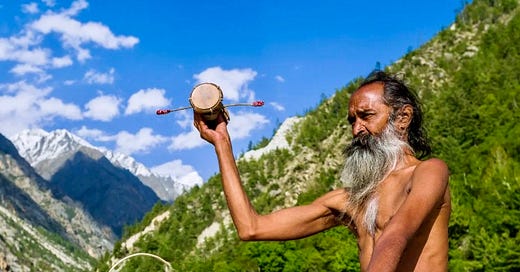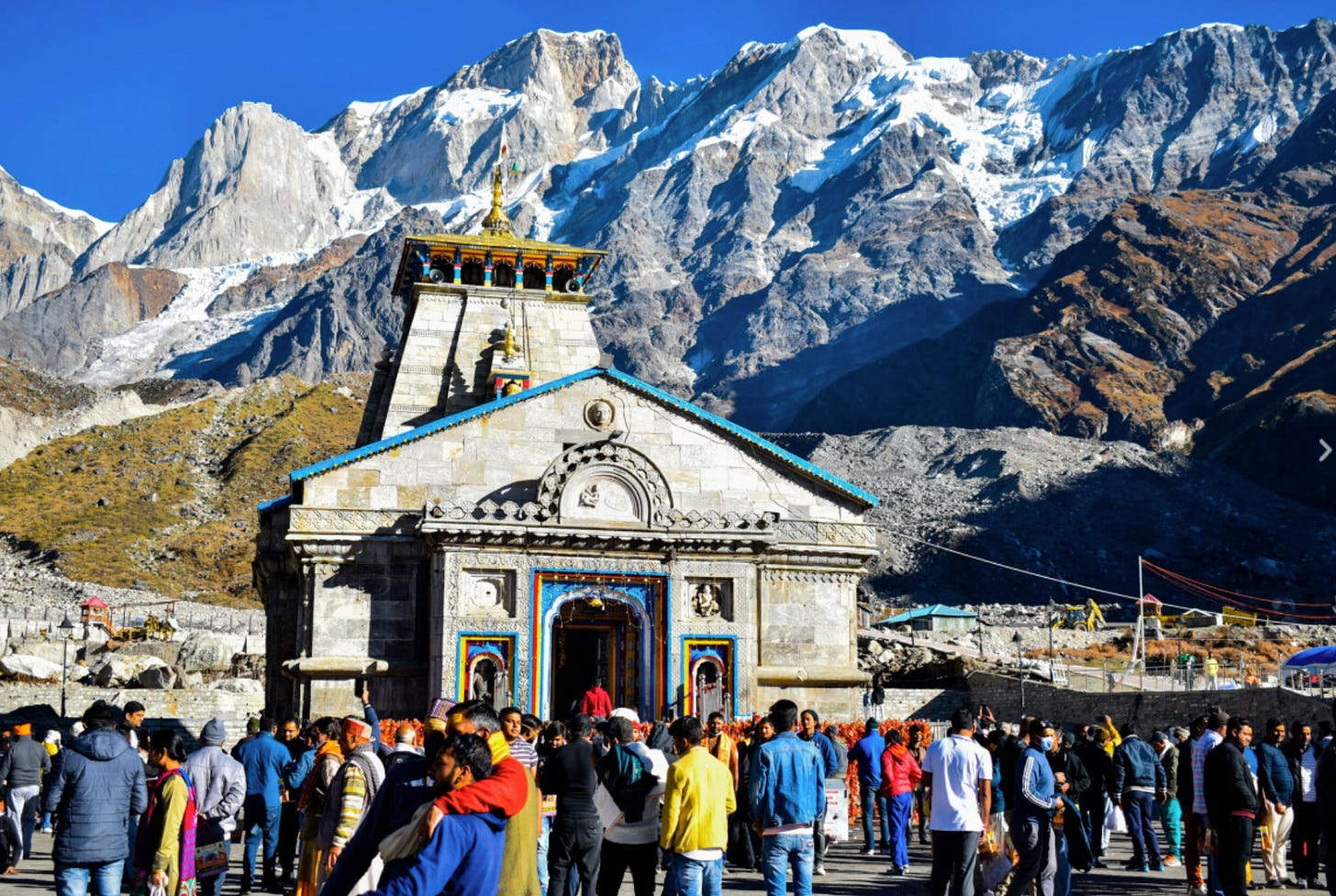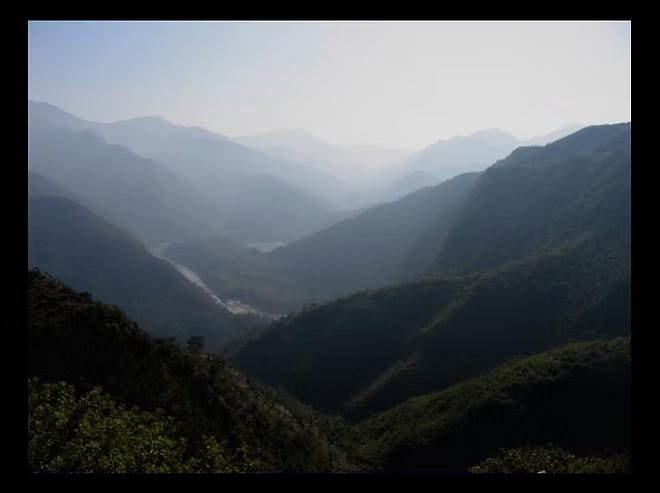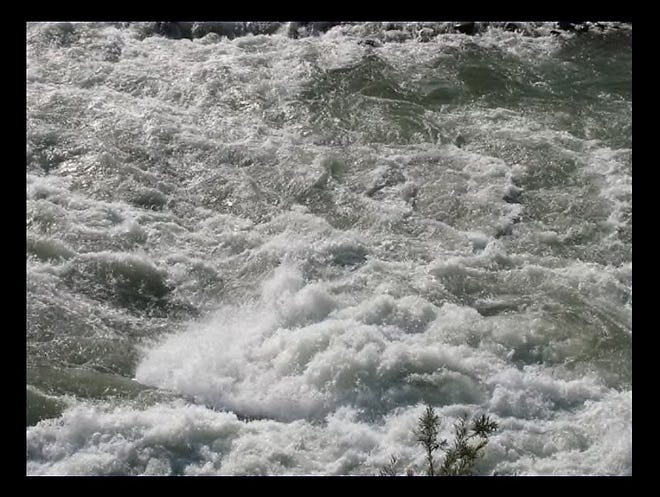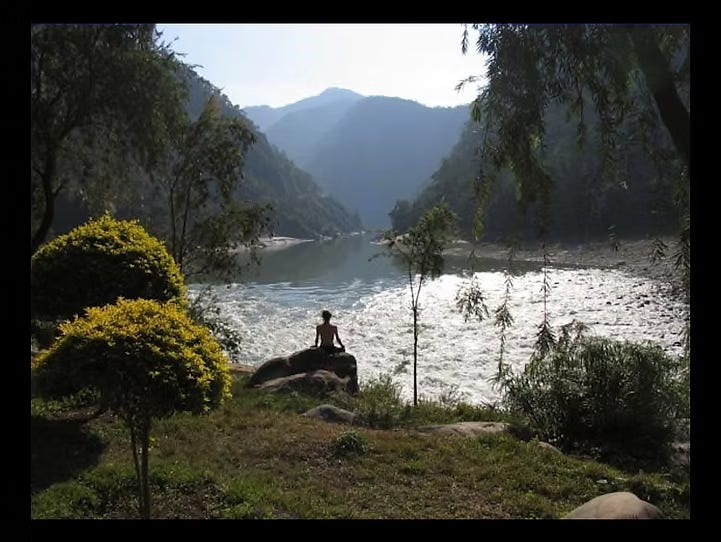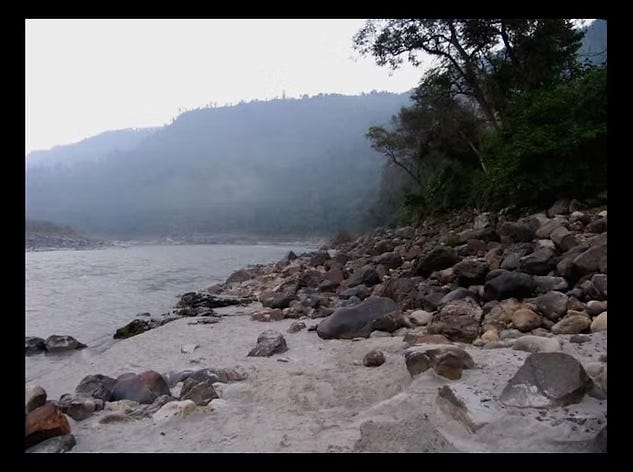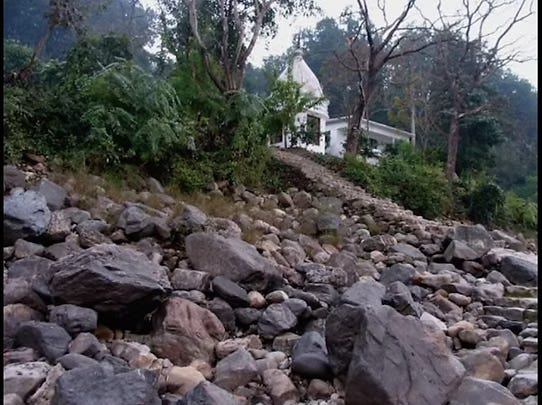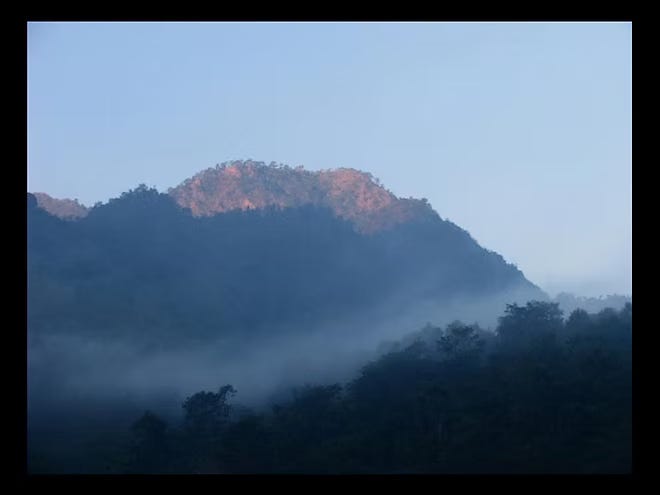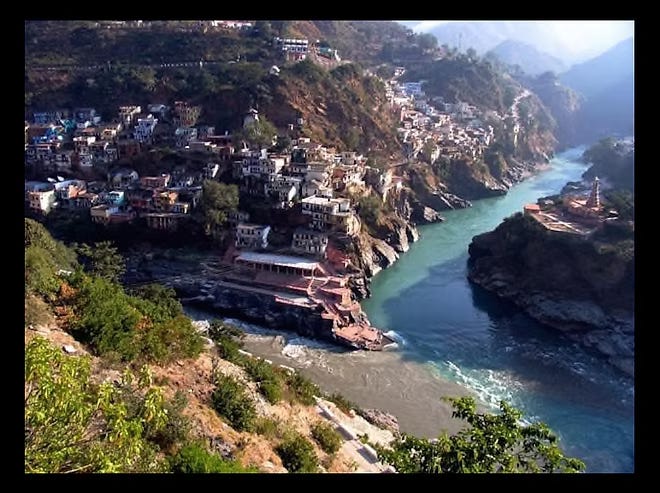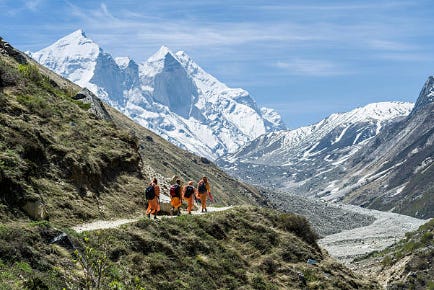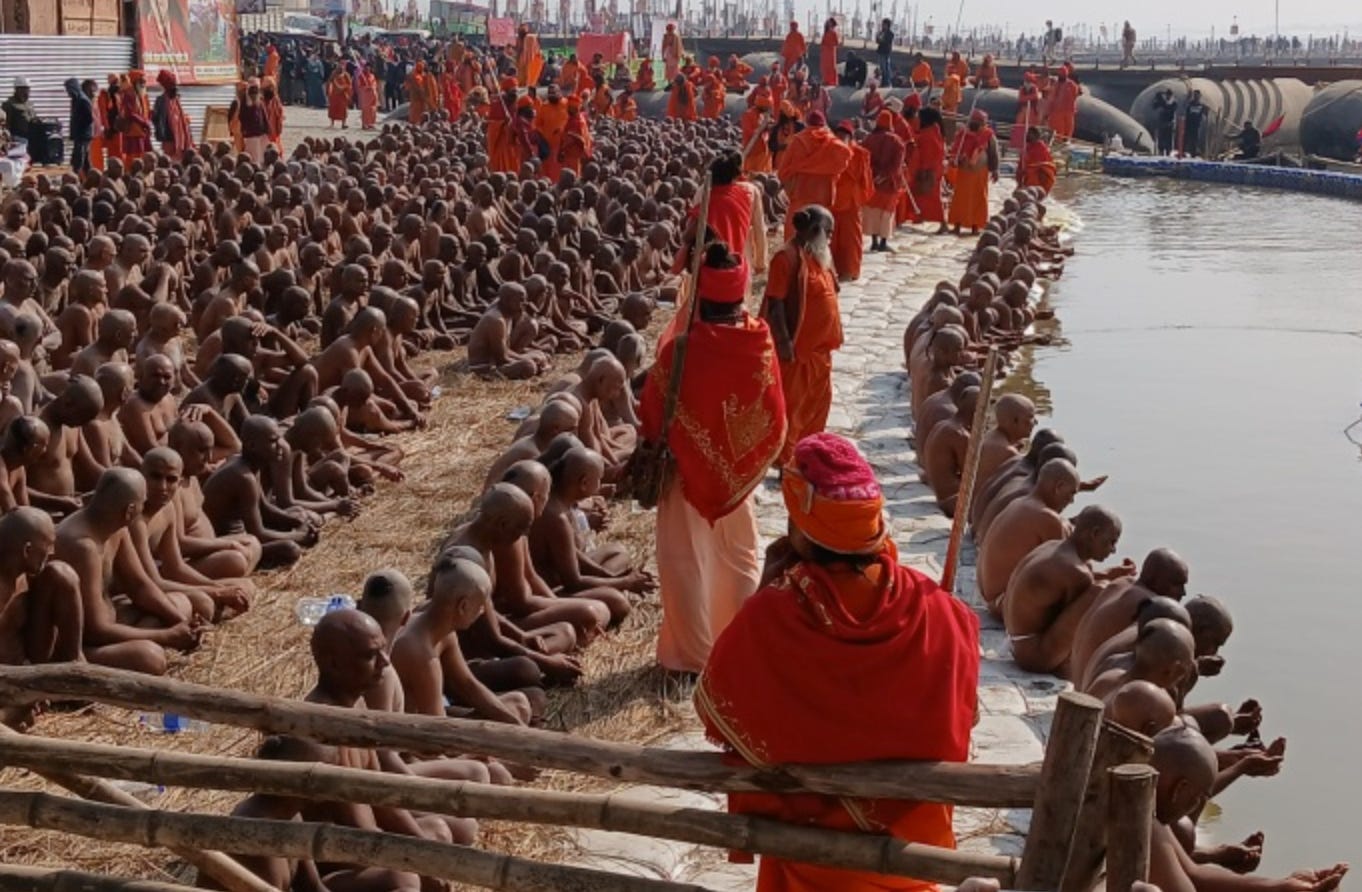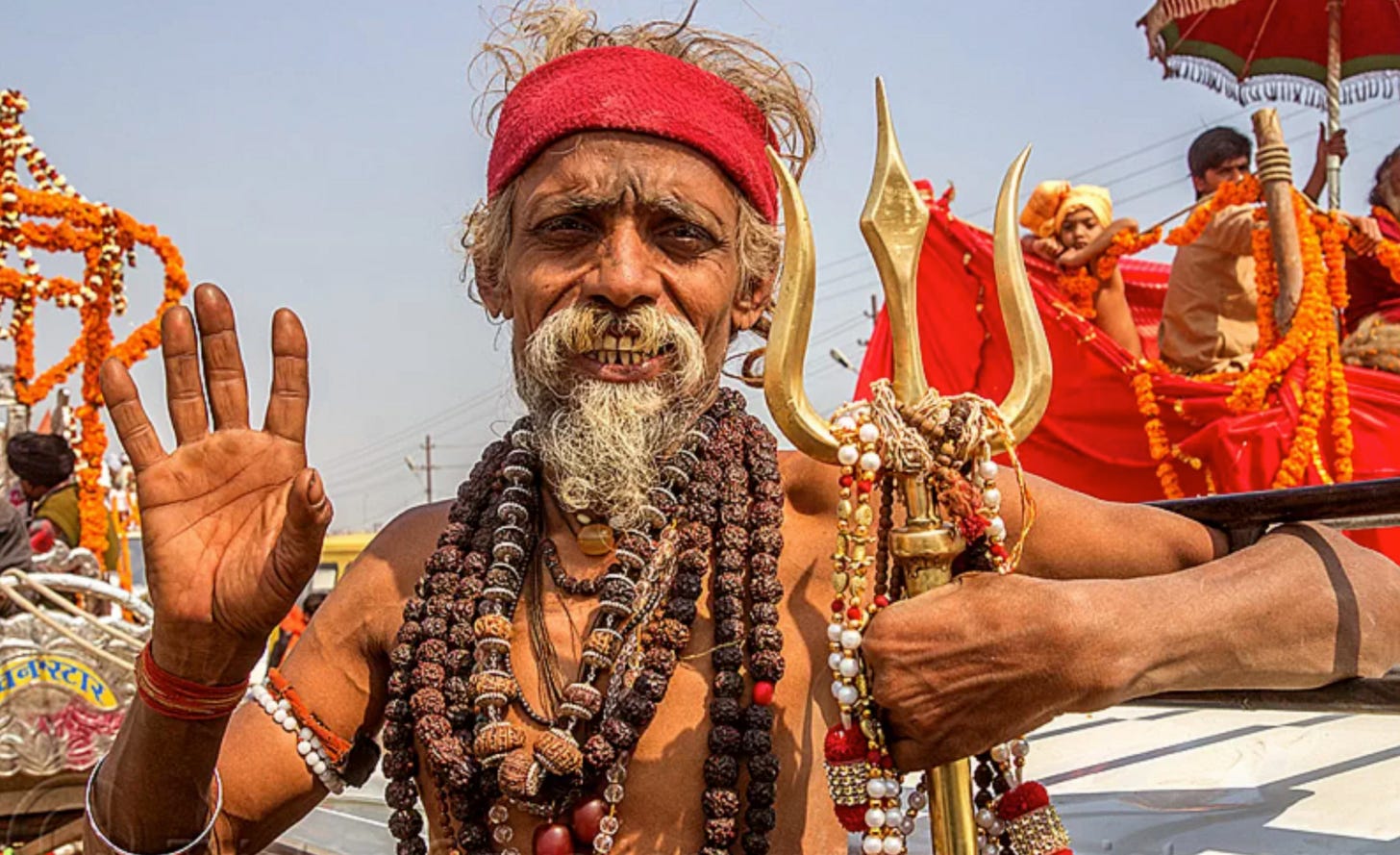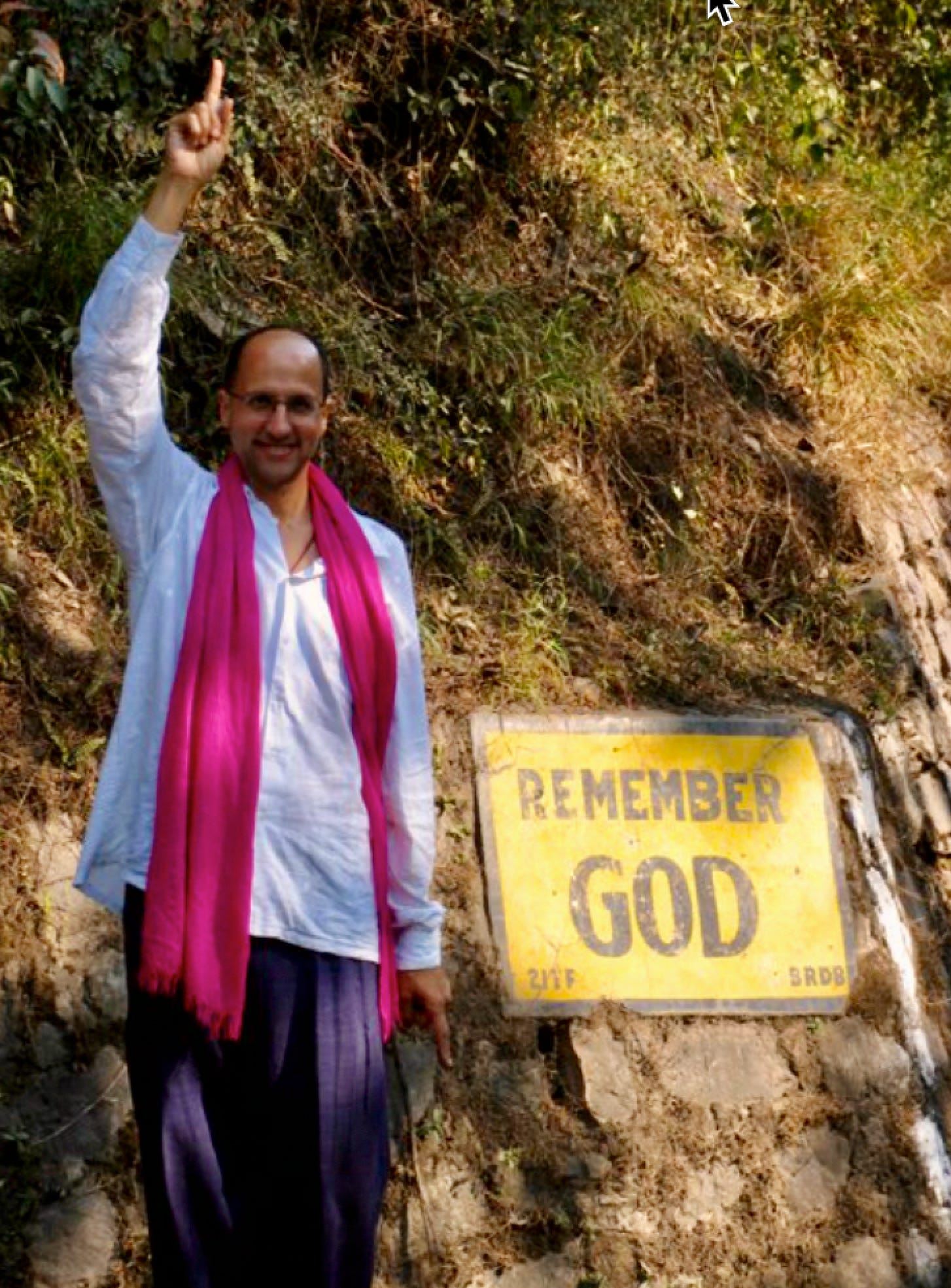I procured my rickshaw in Haridwar after asking all the various drivers there, ‘How much to drive to Rishikesh?’ He was not only the cheapest but he spoke good English, and so I chose him. We settled at 400 rupees.
When we got to the very edge of the town of Rishikesh, he stopped the car and said that he wanted more rupees to go further. It was a masterful ploy. After all, he did drive me to Rishikesh. He was making a bet . . . after all, we now had some kind of relationship, he knew I was a stranger, with my luggage, in the midst of all the honking horns and cows and carts and people and a terribly busy road, and so, he won
I agreed to the extra money, and mainly to protect future travelers from this scam, I told him forcefully that I did not like the way he did it. Actually, I found it amusing. It was only 300 rupees more to take me slightly on the other side Rishikesh, to where I told him I was going originally, that is less than $10USD, but, I must admit, I was still was kind of pissed at the way he did it and pissed at myself for not being more specific.
One of the things that the persistent scams and differences of the Indian culture have taught me is to make very, very clear and specific exactly what you want and to clarify what the other person is offering.
Still, even with all attempts at such clarity, it will be impossible to keep up with all the ploys and plays that will befall you, but nonetheless, this must be one’s practice.
Haridwar is one of the places that the sacred amrit or nectar of immortality fell to earth after the churning of the ocean of milk by the gods and the demons, and every 12 years, the Kumbha Mela is held here. Here, the Ganges has come down fully onto the plains of India, and the sacred river flows east over a thousand miles to enter the sea near Calcutta.
Haridwar (Ghats on the Ganges)
Rishikesh, several miles above Hardwar, is where the Ganges comes down out of the the Himalayan mountains,settling into the flatlands through which it flows to the sea. Rishikesh is a transitional town, a transitional door between two strikingly different 'worlds' of India.
Rishikesh (early morning)
The next day, I hired another driver to leave Rishikesh and head up the Ganges into the Himalayas. As we passed beyond Rishikesh, the road became dramatically uncrowded. After months on the plains of India in bumper-to-bumper traffic, loud, honking, hectic, ugly, dust, smoke filled, crowded with people, taxis, businesses, signboards, monkeys, dogs and cows lining the roads, now, as we drive up the Ganges out of Rishikesh we pass into a quiet, silent, beautiful, ancient India, the India one reads about in the epics such as the Ramayana and the Mahabharata.
Banks of the Ganges 15 miles above Rishikesh
Here is the beginning of the Himalayan foothills that Arjuna passed through as told in the Mahabharata. These are the mountains where hundreds of thousands of pilgrims have made their way up to holy places such as Kedarnath and Badrinath, the abode of the saints and Siddhas for time immemorial.
Badrinath
Rishikesh is full of Hatha Yoga teachers and ashrams. It is where ancient Rishis and Sadhus sojourned at the lower elevations, seeking protection from the freezing Himalayan winters. These holy men usually did not descend onto the plains, but stayed above the dirt and crowds which are often found there. I was reminded of what a sadhu once said to Maharishi Mahesh Yogi, pointing to a bend in the river below the cave where they sat in the Himalaya, “Beyond there we do not go. It is all mud”.
When you go up above Rishikesh, you see what the ancients saw and treasured; the peaks rising up all around you, some of the hills shaped like Mt Kailashian Lingams, and always at their top a temple.
The beautiful ancient holy rivers flow between steep-sided huge hills in a vast valley. The scale of things, the sheer size of these mere foothills, cannot be explained, only experienced.
Valley of the Ganges
You hear what they heard, always the sound of the Ganges - sometimes more quietly, as the river seems glasslike in its downward slide, sometimes it roars in the excited rush of many falls, as it passes quickly, blushing in white waters and waves.
Rapids in the Ganges above Rishikesh
Here, the Ganges appears without the pollution that exhibits itself so terribly as you pass through the Indian cities on the plains below. (This so-called 'pollution' is 'not there' to many Hindus, imbued with a vision born of the time-honored myths of their religion. Almost every Hindu I spoke to found the Ganges absolutely pure, everywhere it appeared. So, let this last description be mine and mine alone. This is a sacred river and, to me, it also stands as a symbol of what has become of the ‘sacred' through misuse and neglect.
(The Ganges at Benaras)
Above Rishikesh, the Ganges flows and rushes and shines and delights. When you are by the Ganges, you feel cleansed, and your mind becomes quieted with the rush of the waters pouring down from the Himalayas, all conspiring to bring peace.
Where I stayed on the Ganges above Rishikesh, I saw the forest with spiders larger than my hand hanging in the trees. I saw the large tracks of tigers that had come down that night to the very same beach
where I bathed in the morning by a small Shiva Temple.
The groves of bamboo, the freshets of small springs, all rushing toward the Ganges. The tops of the high ridges were outlined in trees.
I felt the evening fall and the chill, cold air rush down the valley to the river from the higher mountains above. I understood how important it is to have a fire at night or in the nearly freezing mornings.
I looked at where the tall trees rise up above the river and the hills rise up steeply beyond them for a long time and for a long, long way beyond the trees. As I continued the drive up the valley, here and there, at various bends in the road, I could see the snow-covered Himalayas, the 'laya' or place of eternal snow, ' Himal'. Beyond that is only the sky.
As we went up the Ganges into the foothills of the Himalayas, we came around a bend and passed a timeless tableau- three nearly naked Sadhus, sitting in the morning sun, with a large red trisul, the three-pointed spear sacred to Shiva, planted next to them, all of them bare-chested and barefoot.
I told the driver to stop and back up, and he pulled over to the side of the road. We walked back to where the Sadhus were and approached them. I sensed a mutual recognition between us, and I raised my camera in the gesture I used to inquire, ‘If it might be all right to take a picture?’ They shook their heads affirmatively with a smile and waggled their heads back and forth in the Indian style of saying, ‘Everything is OK, Yes, and Fine’ all together. I expected that they would want some rupees, as every Sadhu I had met up till now had done, but they asked for nothing.
It had been a cold night, and they had spent it outside, like all their nights. Now, the sun was bright and full where they were sitting, and I took care not to block that light for an instant. They were eating some rotis (Indian flatbread) spread with green herbs and tomatoes.
‘Namaste, ’ I said. They looked at me and smiled and said ‘Namaste’ back. I asked them where they were going, “Dev Prayag?”
Dev Prayag
(Dev Prayag is the Divine confluence, where the Bhagirathi and the Alakananda Rivers meet to form the Ganges). I continued to inquire . . . Badrinath, Kedarnath, Gangotri, Gaumukh(where the Ganges river begins)?"
Gaumukh- many say it is where the Ganges begins, flowing out of a glacier. It is at the source of the Bhagirathi River, one of the main tributaries of the Ganges.
Sadhus walking deeper into the Himalaya
These were all pilgrimage sites, far up the Ganges, into the Himalayas. They were Tirthas (holy places) that Sadhus had wandered to and through for thousands of years, following this very path or ‘road’ up the Ganges.
They smiled at my English pronunciation of these great holy places and waggled their heads at all of them in affirmation. One of them offered me some of the roti they were eating, breaking off a piece and offering it to me. I had not been feeling very well in my stomach, and so I passed (I later wished I had taken it, as I now know that it means so much to share food with someone in India).
I liked to ‘hang out’ with anyone I found interesting. I especially practice this with anyone whose pictures I am taking, and I liked being with these Sadhus. They represented an ancient order of religious practitioners who desired to 'experience' the Divine, not just 'believe' in God.
For them, a philosopher was a hypocrite if he did not experience what he talked about. They had left their homes and family and died to their life, indeed, Sadhus actually perform a funeral for themselves as part of the ritual initiation into their order. They did all this to gain Liberation.
Sadhu Initiation Rite at Kumbh Mela 2025
This order of religious wanderers has been around India for thousands of years. These sadhus, like so many who came before them, were wandering up the Ganges, on a pilgrimage to the high, quiet, sacred myth-filled mountains above.
There they meditate in caves and forests, bathing at tirthas (pilgrimage spots) along the holy river, praying and praising God and life.
(Vasishta Gufa- site of the Gufa or cave of Rishi Vasishta)
It is as if they are on vacation in God for their whole life. They accept as grace whatever is given or not given to them, taking only what they need, giving away any excess to others. Now, with only what they were carrying, they were going to spend the winter in tapas (austerity), prayer, and meditation, somewhere in the high Himalayas. These guys seemed happy and different from almost all the Sadhus I had met on the plains.
They were calm, clear, clean, and happy. They each had little bags to carry their meager possessions and needs; they are called 'Baba' bags (Indians often call both the Sadhus and Lord Shiva, ‘Baba', which among other things means ‘Father'), and you see the small bags on many of the wandering renunciates. Their hair was worn in 'Sadhu style’, long, matted, uncombed, and loose. Their skin was beautiful and clear, and their eyes were bright. Each of them wore some small brown Rudraksha beads, sacred representations, and reminders of Lord Shiva, the supreme God/Master and inspiration for all Sadhus and yogis.
A Sadhu wearing Rudraksha Beads at the Kumbha Mela
One of them had a small drum. Pointing at it, I asked him,
A Sadhu with a Damaru in the Himalaya
“What is the drum for? Do you do Bhajan (singing the names of God)?” He appreciated that I knew the term and had noticed the drum. He lifted it up, tilted his head back and forth like there was music playing, and smiled. We all smiled, and there was a happy shared silence.
My driver was uncomfortable. For me, it was nice to just hang out with these guys. For him, they were no better than bums. He was a 'westernized' Hindu and, as many of the modern Hindus often do, felt some embarrassment at the still living representations of their ancient, ‘non-western’ culture and especially at these Sadhus.
Then, the Baba who had offered me some roti, pointed to the sun and waggled his head, put his hands together, and then, raising them over his head, smiled at me.
“Surya Namaskar”, I said (I salute/worship/give thanks to Surya, the sun). I put my thumb and forefinger together and raised my hand to join in an expression of the humble delight of life, and we all smiled and again were silent.
I told them that I was an Ayurvedic practitioner and I had come to India to study Ayurveda. They must have understood some English and seemed to like what I had said.
One of the Babas said something to me. I asked my driver to translate, and he said, ‘They want 10 rupees. ’ I knew this was not accurate. And with a stern voice, I said to him, “That is not what he said!”
My driver was chastened by this, and then he translated again:
“He said that Ayurveda was good work. It is a noble thing to do.”
After he said this, the Sadhus looked at me and smiled. ( I think they understood what had just occurred.) We sat in silence a while longer. I took each of their hands and held them. Then I gave one of them 100 rupees. It was rolled up, and he did not even unroll it. He just gestured at the sky and the sun above, seeming to say, “It is a great and wondrous mystery. We are always fed from the day of our birth. There is nothing to worry about. We are happy and blessed. God is great and there is nothing but God.”
I agreed with them in a shared intimacy. I looked each of them in the eyes, all of us smiling together, and then I got up and left.
"Now, sitting by the side of the road, I look for them. Remembering these sanyasis, tears well up. They were so very kind to me. They radiated brightness. Yogis are many, but it is these wandering Sadhus that I love."
– the Sur Ramkali of Latif
This all occurred in 2004 as I traveled in India after my graduation from Ayurveda College. Here I am by a road sign on the road above Rishikesh. I have just bathed in the Ganges. I have one finger pointing up and one finger pointing down; It is a mudra of ‘Not one God or many Gods, ‘Only God. I am just fakin’ it.

